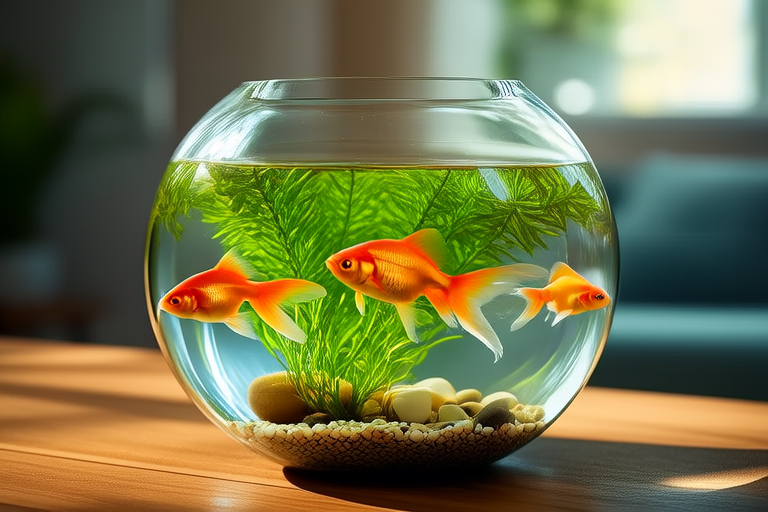How to Create the Perfect Aquarium Environment for Your Goldfish
Welcome to your guide on creating the perfect aquarium environment for your goldfish. Whether you’re a beginner or an experienced aquarist, this comprehensive article will provide you with all the necessary information to ensure your goldfish thrive in their aquatic home.
Selecting an Appropriate Tank Size
The first step in setting up your goldfish’s habitat is choosing the right tank size. Goldfish are active swimmers and require ample space to move around comfortably. A general rule is to provide at least 20 gallons of water per goldfish. Larger tanks offer more stability in terms of water quality and temperature, which is crucial for the health of your fish.
Filtration Systems
An efficient filtration system is vital for maintaining water quality. It helps remove waste, excess food, and other harmful substances from the tank. There are three main types of filtration: mechanical, biological, and chemical. Mechanical filtration removes debris, biological filtration converts harmful ammonia into less toxic compounds, and chemical filtration absorbs dissolved organic compounds. A combination of these methods ensures a clean and healthy environment for your goldfish.
Water Quality Maintenance
Maintaining optimal water quality is essential for the health of your goldfish. Regular water changes, typically 10-20% weekly, help keep the water clean and stable. Testing the water regularly for pH, ammonia, nitrite, and nitrate levels is also important. Aim for a pH between 6.5 and 8.0, and keep ammonia and nitrite levels at zero. Nitrate levels should be kept as low as possible, ideally below 20 ppm.
Temperature Control
Goldfish are coldwater fish and prefer temperatures between 65°F and 75°F (18°C to 24°C). Avoid drastic temperature fluctuations, as they can stress your fish. If necessary, use a heater or cooler to maintain a stable temperature within this range.
Lighting Requirements
Goldfish don’t have specific lighting requirements, but providing a light cycle mimicking day and night can help them establish a routine. Use a timer to turn the lights on for 8-12 hours daily. Avoid overly bright lights that could cause stress or algae growth. Consider using a full-spectrum LED or fluorescent bulb for optimal plant growth if you include live plants in your aquarium.
Substrate and Decoration Choices
The substrate you choose for your tank can affect water quality and aesthetics. Gravel or sand are popular options, though gravel is easier to clean. Avoid substrates with sharp edges that could injure your fish. Decorations such as rocks, caves, and driftwood can provide hiding spots and enhance the visual appeal of your tank. Ensure decorations are safe for aquarium use and won’t leach harmful chemicals into the water.
Suitable Plants
Including live plants in your aquarium can benefit both the environment and your goldfish. Plants help oxygenate the water, absorb nutrients, and provide hiding places. Hardy species like Java moss, Anubias, and Amazon swords are excellent choices for goldfish tanks. Floating plants can also help reduce algae growth by blocking sunlight.
Feeding Guidelines
Goldfish are omnivores and require a balanced diet. Feed them a variety of foods, including pellets, flakes, and occasional treats like bloodworms or brine shrimp. Feed small portions multiple times a day, ensuring they finish eating within a few minutes. Overfeeding can lead to poor water quality and health issues. Remove any uneaten food promptly to prevent pollution.
Common Health Issues to Watch For
Regular observation is key to identifying potential health issues early. Look out for signs of illness such as lethargy, loss of appetite, unusual swimming behavior, or physical symptoms like bloating or fin damage. Common health problems include swim bladder disorder, fin rot, and parasites. Addressing these issues promptly can prevent further complications.
Regular Monitoring and Adjustments
Maintaining a healthy environment for your goldfish requires ongoing attention. Regularly check water parameters, perform water changes, and monitor your fish’s behavior. Be prepared to make adjustments based on changing conditions or signs of stress. Consistent care and vigilance will ensure your goldfish remain happy and healthy in their aquatic home.
By following these guidelines, you’ll create a thriving habitat where your goldfish can flourish. Remember, a well-maintained aquarium is not just beneficial for the health of your fish but also adds beauty and tranquility to your living space.
